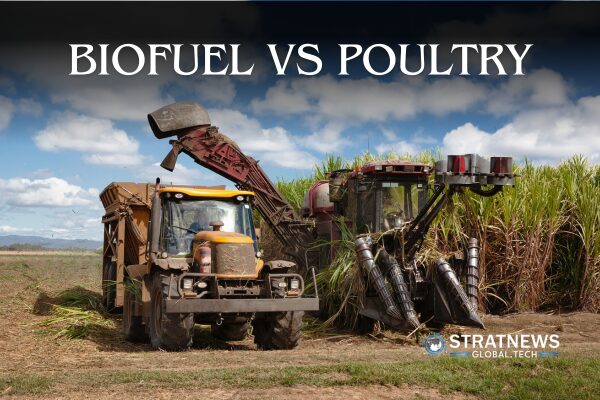India’s Biofuel Drive Fuels Feed Costs, Squeezing Small Poultry Farmers
In Ghazipur, a quiet town along the Ganges river in northern India, farmer Satyadev Prajapati is witnessing a troubling drop in egg production from his 350 free-range hens. The reason: a sharp 40% surge in poultry feed prices, driven mainly by rising maize costs and India’s biofuel drive.
Biofuel Ambitions Trigger Feed Price Rise
India’s growing biofuel initiative, aimed at cutting oil imports and reducing carbon emissions, has pushed demand for maize, a key ingredient in both ethanol and animal feed. This increased competition is hurting small poultry producers like Prajapati, who rely on affordable maize to feed their flocks.
“If maize prices go up but egg prices stay the same, we suffer,” Prajapati said.
The Indian government plans to blend 20% ethanol into every litre of petrol sold nationwide by the end of 2025. Ethanol, derived from crops like maize and sugarcane, now competes directly with livestock feed for raw materials.
Ethanol Gains, Farmers Strain
Government data show that ethanol blending saved India around ₹1.06 trillion (approximately $12.37 billion) in crude oil imports from 2014 to 2024. It also helped avoid about 54.4 million metric tonnes of carbon dioxide emissions, roughly equal to taking 12 million petrol-powered cars off the road each year.
Ethanol production using maize has grown from 1 million metric tonnes in 2022 to more than 6 million in 2024, with estimates projecting it to reach 11 million tonnes by 2025. As a result, about one-third of India’s maize crop now goes to ethanol, while the poultry sector, which consumes 60%, faces tight supply and rising costs.
Struggles of Small Poultry Farmers
Prajapati has resorted to cheaper, lower-quality feed, reducing his hens’ egg output. Like many small farmers, he is already challenged by disease outbreaks, heatwaves, and limited access to credit.
In nearby Varanasi, chick and feed supplier Prince Rajput said rising maize prices have also cut into his profits. He noted that small farmers lack financial buffers and cannot negotiate favourable supply deals, leaving them more vulnerable than large producers.
“Poultry doesn’t seem to be a government priority. Even loans are hard to get,” Rajput said.
India, once a maize exporter, is now importing the grain to meet domestic needs. According to experts, current maize demand—driven by fuel, alcohol, and industry—already exceeds local production.
Meeting India’s ethanol targets would require dedicating land nearly seven times the size of New York City solely for biofuel crops, says Ramya Natarajan from the Centre for Study of Science, Technology and Policy (CSTEP).
Seeking Solutions for a Sustainable Future
To ease the pressure on food systems, experts recommend shifting to second-generation (2G) biofuels, which are produced from crop residues and non-edible biomass. This method could help India meet its fuel goals without sacrificing food security or increasing land use.
Natarajan suggested the government support 2G biofuel technology and define clearer guidelines for what counts as sustainable ethanol. Encouraging innovation while protecting agricultural sectors like poultry could create a more balanced approach to energy and food needs.
with inputs from Reuters


